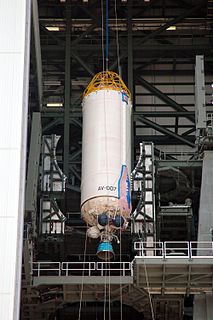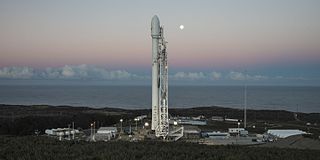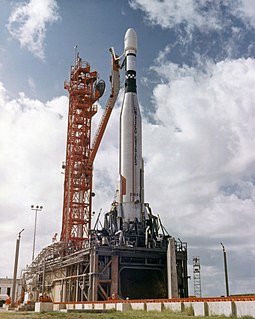
Mariner 3 was one of two identical deep-space probes designed and built by the Jet Propulsion Laboratory (JPL) for NASA's Mariner-Mars 1964 project that were intended to conduct close-up (flyby) scientific observations of the planet Mars and transmit information on interplanetary space and the space surrounding Mars, televised images of the Martian surface and radio occultation data of spacecraft signals as affected by the Martian atmosphere back to Earth. It was the third of ten spacecraft within the Mariner program.

The Centaur is a family of rocket propelled upper stages currently produced by U.S. launch service provider United Launch Alliance, with one main active version and one version under development. The 3.8 m diameter Common Centaur/Centaur III flies as the upper stage of the Atlas V launch vehicle, while the 5.4 m diameter Centaur V is being developed as the upper stage of ULA's new Vulcan rocket.

Cape Canaveral Air Force Station (CCAFS) is an installation of the United States Air Force Space Command's 45th Space Wing.

Delta IV is a group of five expendable launch systems in the Delta rocket family introduced in the early 2000s. Originally designed by Boeing's Defense, Space & Security division for the Evolved Expendable Launch Vehicle (EELV) program, the Delta IV became a United Launch Alliance (ULA) product in 2006. The Delta IV was and is primarily a launch vehicle for United States Air Force military payloads, but has also been used to launch a number of U.S. government non-military payloads and a single commercial satellite.

Atlas V is the fifth major version in the Atlas rocket family. It is an expendable launch system originally designed by Lockheed Martin, now being operated by United Launch Alliance (ULA), a joint venture between Lockheed and Boeing.

Launch Complex 39 (LC-39) is a rocket launch site at the John F. Kennedy Space Center on Merritt Island in Florida, United States. The site and its collection of facilities were originally built for the Apollo program and later modified for the Space Shuttle program.

Space Launch Complex 3 (SLC-3) is a launch site at Vandenberg Air Force Base that consists of two separate launch pads. SLC-3E (East) is currently used by the Atlas V launch vehicle, while SLC-3W (West) has been demolished.

United Launch Alliance (ULA) is a US launch service provider that manufactures and operates a number of rocket vehicles capable of orbiting spacecraft. It was formed as a joint venture between Lockheed Martin Space Systems and Boeing Defense, Space & Security in December 2006. United States government launch customers include the DoD and NASA, as well as other organizations.

Cape Canaveral Air Force Station Space Launch Complex 17 (SLC-17), previously designated Launch Complex 17 (LC-17), was a launch site at Cape Canaveral Air Force Station, Florida used for Thor and Delta rocket launches between 1958 and 2011.

Launch Complex 36 (LC-36)—formerly known as Space Launch Complex 36 (SLC-36) from 1997 to 2010—is a launch complex at Cape Canaveral Air Force Station in Brevard County, Florida. It was used for Atlas launches by NASA and the US Air Force from 1962 until 2005.

Cape Canaveral Air Force Station Space Launch Complex 40 (SLC-40), previously Launch Complex 40 (LC-40) is a launch pad for rockets located at the north end of Cape Canaveral, Florida.
Space Launch Complex 20 (SLC-20), previously designated Launch Complex 20 (LC-20), is a launch site at Cape Canaveral Air Force Station, Florida. SLC-20 is located at the northern terminus of ICBM Road, between Space Launch Complex 19 and Space Launch Complex 34.

Atlas is a family of US missiles and space launch vehicles that originated with the SM-65 Atlas. The Atlas intercontinental ballistic missile (ICBM) program was initiated in the late 1950s under the Convair Division of General Dynamics. Atlas was a liquid propellant rocket burning RP-1 fuel with liquid oxygen in three engines configured in an unusual "stage-and-a-half" or "parallel staging" design: two outboard booster engines were jettisoned along with supporting structures during ascent, while the center sustainer engine, propellant tanks and other structural elements remained connected through propellant depletion and engine shutdown.

The Wideband Global SATCOM system (WGS) is a high capacity satellite communications system planned for use in partnership by the United States Department of Defense (DoD) and the Australian Department of Defence. The system is composed of the Space Segment satellites, the Terminal Segment users and the Control Segment operators.

Space Launch Complex 4 (SLC-4) is a launch and landing site at Vandenberg Air Force Base with two pads, both of which are used by SpaceX for Falcon 9 launch operations; operating as Landing Zone 4 (LZ-4) for SpaceX landings.

The Commercial Titan III, also known as CT-3 or CT-III, was an American expendable launch system, developed by Martin Marietta during the late 1980s and flown four times during the early 1990s. It was derived from the Titan 34D, and was originally proposed as a medium-lift expendable launch system for the US Air Force, who selected the Delta II instead. Development was continued as a commercial launch system, and the first rocket flew in 1990. Due to higher costs than contemporary rockets such as the Ariane 4, orders were not forthcoming, and the CT-3 was retired in 1992.

Launch Complex 13 (LC-13) was a launch complex at Cape Canaveral Air Force Station, the third-most southerly of the original launch complexes known as Missile Row, lying between LC-12 and LC-14. The LC-13 site is currently leased by SpaceX and has been renovated for use as Landing Zone 1 and Landing Zone 2, their east coast landing location for returning Falcon 9 and Falcon Heavy launch vehicle booster stages.
The Vertical Integration Building was a building at Cape Canaveral Air Force Station (CCAFS) in Florida, located at the far south end of the industrial area supporting SLC-40 and SLC-41. The building was one of the facilities of the Integrate-Transfer-Launch complex that was used to support Titan III and Titan IV launches. These expendable launch systems were operated by the United States Air Force, both at CCAFS and at Vandenberg Air Force Base in California from 1965 to 2005. Several Titan rockets could be vertically integrated at the same time inside the Vertical Integration Building. In that respect it was a precursor to the Vehicle Assembly Building used for the Saturn V and Space Shuttle.

Vulcan is a next generation heavy-lift launch vehicle under development by the United Launch Alliance (ULA) to meet the demands of the United States Air Force's National Security Space Launch (NSSL) competition and launch program.



















